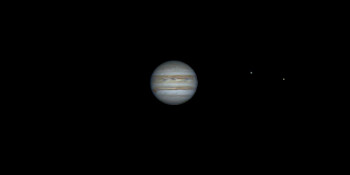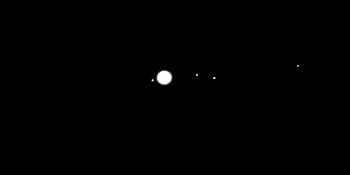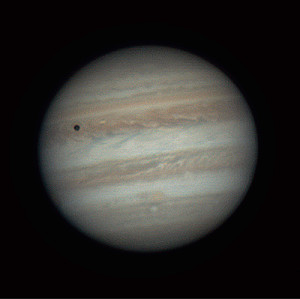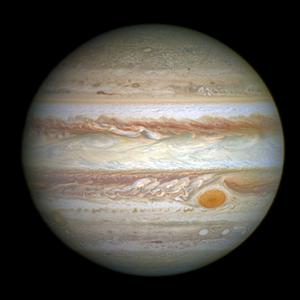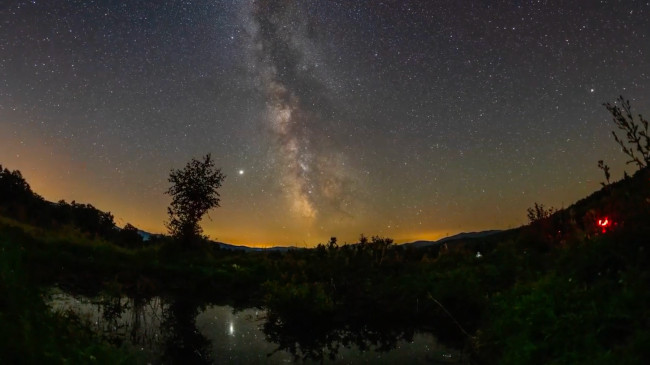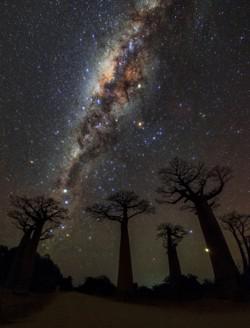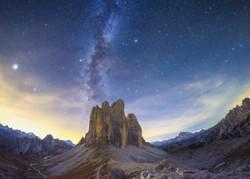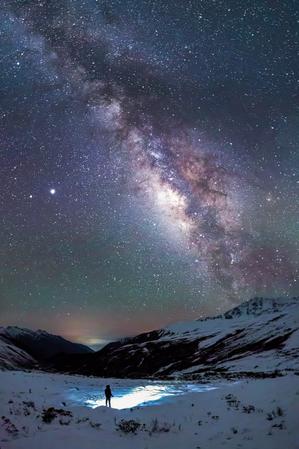Glossary term: Jupiter
Description: Jupiter is the largest planet in the Solar System and the fifth major planet from the Sun. It is a gas giant with a radius of 71,300 kilometers (km), about 11 times the radius of the Earth. The mass of Jupiter (318 times the mass of the Earth) is greater than all the other planets and the smaller bodies in the Solar System put together.
Its typical distance from the Sun is 778 million km, about five astronomical units (Earth–Sun distances), taking a little under 12 years to complete one orbit. As of 2023, astronomers have detected more than 90 moons or natural satellites orbiting Jupiter.
It is visible with the naked eye. Its name in English derives from the Roman king of the gods. Observed in a small telescope we can see cloud belts of different colors and a giant red circular storm region (the so-called Great Red Spot). A few space probes have been sent to Jupiter over the past decades, and in 2016 the NASA spacecraft Juno started exploring Jupiter and its moons in much greater detail.
Related Terms:
- Astronomical Unit
- Galilean Satellites
- Gas Giant
- Giant Planet
- Great Red Spot
- Outer Planets
- Planet
- Solar System
See this term in other languages
Term and definition status: This term and its definition have been approved by a research astronomer and a teacher
The OAE Multilingual Glossary is a project of the IAU Office of Astronomy for Education (OAE) in collaboration with the IAU Office of Astronomy Outreach (OAO). The terms and definitions were chosen, written and reviewed by a collective effort from the OAE, the OAE Centers and Nodes, the OAE National Astronomy Education Coordinators (NAECs) and other volunteers. You can find a full list of credits here. All glossary terms and their definitions are released under a Creative Commons CC BY-4.0 license and should be credited to "IAU OAE".
Related Media
Jupiter's Rotation, by Vishal Sharma, India
Credit: Vishal Sharma/IAU OAE
License: CC-BY-4.0 Creative Commons Attribution 4.0 International (CC BY 4.0) icons
Jupiter Moons Movie2, by Nicolas Hurez, Paul-Antoine Matrangolo, and Carl Pennypacker, United States of America
Credit: Nicolas Hurez, Paul-Antoine Matrangolo and Carl Pennypacker/IAU OAE
License: CC-BY-4.0 Creative Commons Attribution 4.0 International (CC BY 4.0) icons
Jupiter, Io and its shadow, by Ralf Burkart, Germany
Credit: Ralf Burkart/IAU OAE
License: CC-BY-4.0 Creative Commons Attribution 4.0 International (CC BY 4.0) icons
Jupiter
Credit: NASA, ESA, and A. Simon (Goddard Space Flight Center) credit link
License: CC-BY-4.0 Creative Commons Attribution 4.0 International (CC BY 4.0) icons
Flowing Night Sky
Credit: Robert Barsa/IAU OAE
License: CC-BY-4.0 Creative Commons Attribution 4.0 International (CC BY 4.0) icons
Milky Way over Avenue of Baobabs
Credit: Amirreza Kamkar/IAU OAE
License: CC-BY-4.0 Creative Commons Attribution 4.0 International (CC BY 4.0) icons
The Milky Way Across the Zenith
Credit: Ohnishi Kouji/IAU OAE
License: CC-BY-4.0 Creative Commons Attribution 4.0 International (CC BY 4.0) icons
To guard the Stars and the Sea Together
Credit: Likai Lin/IAU OAE
License: CC-BY-4.0 Creative Commons Attribution 4.0 International (CC BY 4.0) icons
Romanian Orion
Credit: Alex Conu/IAU OAE
License: CC-BY-4.0 Creative Commons Attribution 4.0 International (CC BY 4.0) icons
The Pillar of Creation
Credit: Giorgia Hofer/IAU OAE
License: CC-BY-4.0 Creative Commons Attribution 4.0 International (CC BY 4.0) icons
Jupiter, Venus, Moon Conjunction
Credit: Joslynn Appel/IAU OAE (CC BY 4.0)
License: CC-BY-4.0 Creative Commons Attribution 4.0 International (CC BY 4.0) icons
Milky Way Stargazer
Credit: Jianfeng Dai/IAU OAE (CC BY 4.0)
License: CC-BY-4.0 Creative Commons Attribution 4.0 International (CC BY 4.0) icons
